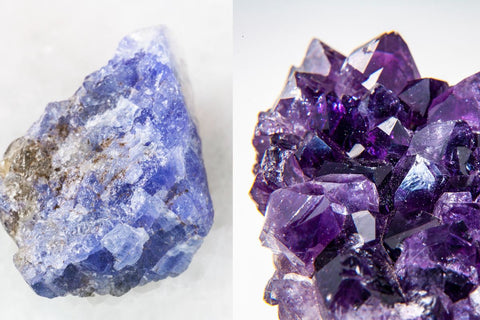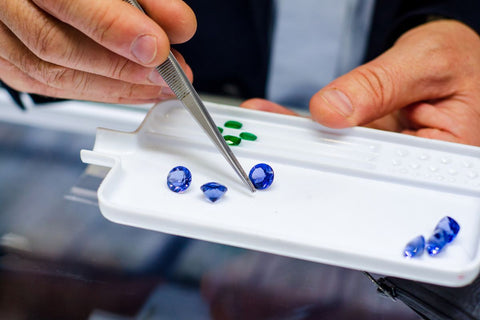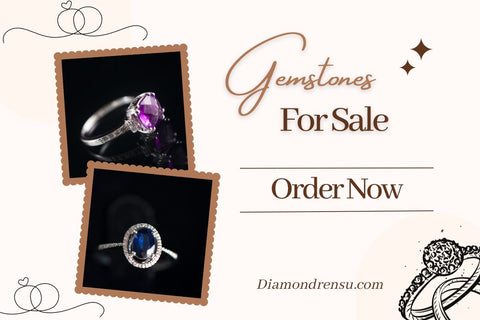
Amethyst vs Tanzanite: Comparing Characteristics and Value
When considering the purchase of a precious gemstone, you might find yourself weighing the merits of amethyst and tanzanite. Amethyst, known for its striking purple hue, has been cherished throughout history for its beauty and perceived healing properties. A variety of quartz, amethyst's color can range from a light, pinkish violet to a deep, rich purple. Its versatility and affordability make it a popular choice for jewelry, with its market remaining substantial despite the presence of synthetic alternatives.
On the other hand, tanzanite is a newer discovery that quickly took the gemstone market by storm with its unique, vibrant blue to violet color. Found primarily in the Merelani Hills of Tanzania, tanzanite is a rare variety of the mineral zoisite and is highly valued for its rarity and pleochroism, meaning it exhibits different colors when viewed from different angles. Unlike the more ubiquitous amethyst, the global supply of tanzanite is quite limited, adding to its allure and perceived value. Choosing between these two gemstones ultimately depends on personal taste, budget, and the significance you attribute to rarity and origin.
Gemstone Overview
In this section, you'll learn about the distinct characteristics and aspects of amethyst and tanzanite, from their origins and physical traits to their value and how to take care of them.
Origins
Amethyst is primarily mined in Brazil and Uruguay, offering rich purple hues. Tanzanite is found only in the Merelani Hills of Northern Tanzania, making it significantly rarer. These locations contribute to the gemstones' unique qualities and rarity.
Color Profiles
Amethyst exhibits colors ranging from light lilac to deep purple. Tanzanite is known for its striking blue-purple hues; however, it can also present a pure blue or violet color, dependent on its crystal orientation.
Physical and Chemical Properties
| Property | Amethyst | Tanzanite |
|---|---|---|
| Chemical Composition | SiO2 - Silicon Dioxide with traces of iron | Ca2Al3(SiO4)(Si2O7)O(OH) - Calcium Aluminum Silicate |
| Color | Purple (various shades) | Blue to violet or purple |
| Crystal System | Hexagonal | Orthorhombic |
| Hardness (Mohs Scale) | 7 | 6.5 - 7 |
| Specific Gravity | 2.65 | 3.35 |
| Cleavage | None | Perfect in two directions |
| Refractive Index | 1.544 - 1.553 | 1.691 - 1.700 |
| Luster | Vitreous | Vitreous |
| Transparency | Transparent to translucent | Transparent to translucent |
| Origin | Various locations globally, including Brazil and Zambia | Exclusive to the Merelani Hills in Tanzania |
Amethyst, a variety of quartz, is composed of silicon dioxide with iron impurities dictating its purple color. Tanzanite is a type of zoisite and alters its color through vanadium impurities. Each gemstone's chemical composition and specific gravity play a role in its physical properties and formation.
Formation and Geology

Amethyst forms in geodes under volcanic activity, while tanzanite requires a unique set of geological conditions present only in a small area of Tanzania. The formation processes influence the gemstones' structure and available quantities.
Mineral Hardness and Durability
Both gemstones are rated on the Moh's Hardness Scale: amethyst at a 7 and tanzanite slightly lower, making it more susceptible to scratches. The hardness and durability are essential for wearing and maintaining the gemstones.
Market Value and Rarity
Tanzanite's rarity and one-source location contribute to its higher price and value. Amethyst's more abundant availability tends to lower its cost, though high-quality deep purple amethyst can demand premium prices.
Popular Cuts and Shapes

Quality cuts optimize the color and clarity of these gemstones. Amethyst and tanzanite are fashioned into diverse shapes such as cushion, oval, and emerald-cut to highlight their beauty.
Historical Significance and Uses
Historically, amethyst was valued by royalty for its power and beauty and has been used as a birthstone for February. Tanzanite, discovered in the 20th century, quickly gained popularity and is used to celebrate December birthdays.
Gemstone Metaphysics
Believers in the metaphysical ascribe amethyst to promoting clarity and alleviating anxiety, associating it with the crown and third eye chakras. Tanzanite is thought to aid in communication and confidence, tied to the throat chakra.
Jewelry Care and Maintenance
You should clean amethyst and tanzanite jewelry with mild soap and water, avoiding exposure to high heat which can alter the color. Regular checks for loose settings can prevent loss of these precious stones.
Comparative Analysis
When comparing, consider both tanzanite's and amethyst's density, color saturation, and clarity. Tanzanite is generally more valuable due to its rarity and unique origin, while amethyst is more durable and readily available, making it an everyday jewelry choice.
Frequently Asked Questions
In exploring amethyst and tanzanite, you may have specific questions about their physical properties and how they compare to one another. This section aims to address some of the most common inquiries.
What distinguishes the hardness level between amethyst and tanzanite?
Amethyst, a variety of quartz, is rated at 7 on the Mohs scale of hardness, making it relatively resistant to scratches. Tanzanite, on the other hand, is softer with a Mohs hardness rating of 6 to 6.5, indicating it is more prone to scratches and requires more careful handling.
How do amethyst and tanzanite differ in terms of cleavage and fracture properties?
Amethyst typically has no cleavage and breaks with a conchoidal fracture, whereas tanzanite exhibits perfect cleavage in one direction, making it more susceptible to splitting if struck with sufficient force.
Can amethyst and tanzanite be worn together without clashing?
Yes, amethyst and tanzanite can complement each other when worn together, with amethyst’s purple shades melding well with tanzanite’s blue to violet hues. It is important to consider the setting and design to ensure harmony between the two stones.
What factors contribute to the wide price range of tanzanite?
Tanzanite’s price can vary widely based on several factors, including color saturation, size, clarity, and cut quality. Deeper, more vivid blues and purples with good clarity typically command higher prices.
What are the differences in density and transparency between amethyst and tanzanite?
Amethyst has a lower density than tanzanite, contributing to the differences in weight when comparing stones of the same size. Both gemstones can be transparent, but tanzanite is often more notably translucent to transparent with fewer inclusions than amethyst.
Which other gemstones are commonly confused with amethyst, and why?
Gemstones such as purple sapphire, purple spinel, and purple fluorite may sometimes be mistaken for amethyst due to their similar color. However, their differences in hardness, refractive index, and other optical properties can be used to distinguish between them.
Checkout some of our top collections:










